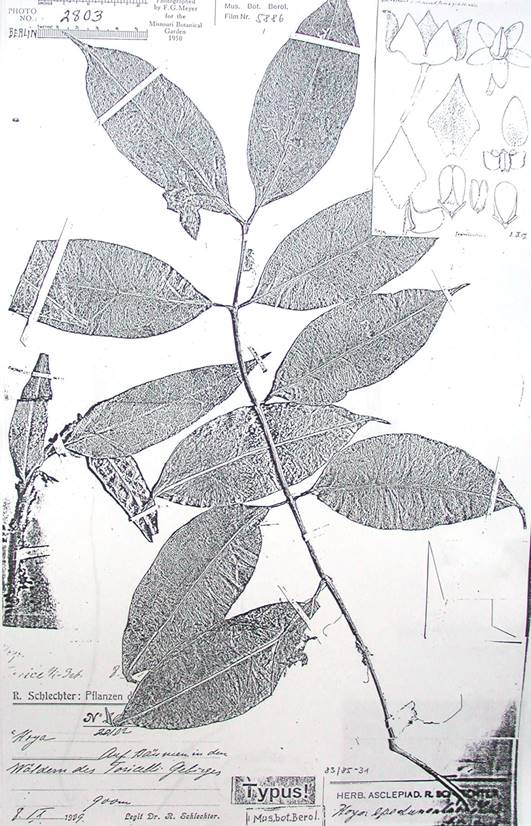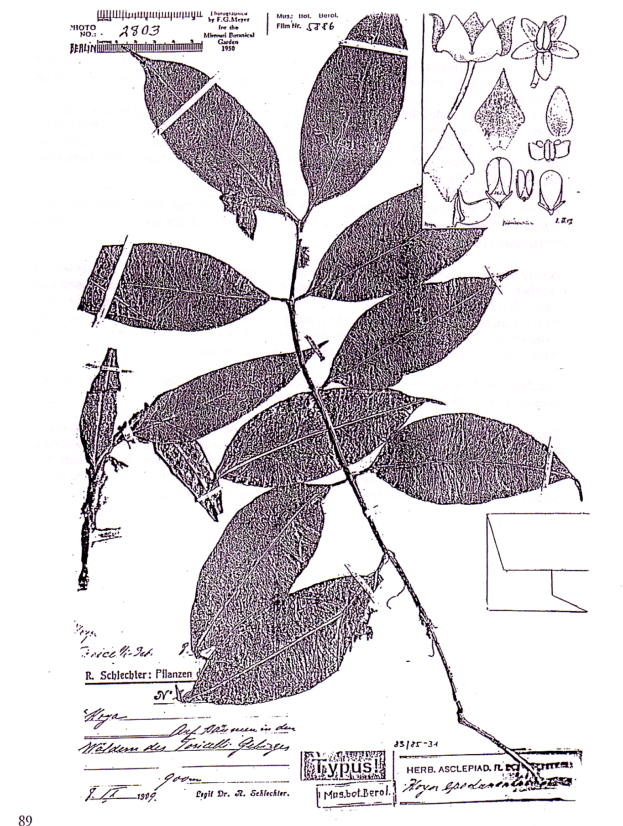
Hoya epedunculata Schlechter 1913
Type description:
In Botanische Jahrbücher 50 (1913) 133. “Die Asclepiadaceae von Deutsch Neu Guinea” R. Schlechter. 43. H. epedunculata Schltr. n. sp. — Suffrutex epiphyticus, parum ramosus, scandens, Rami filiformes, flexuosi, bene foliati, teretes, glabri, Folia patentia vel patula, petiolata, elliptica, acuminata, subcoriacea, utrinque glabra, pedunculo, glabra, crassiusculo, superne leviter sulcato. Inflorescentiae sessiles, umbelliformes, pauci- vel pluri-(ad 5-) florae pedicellis filiformibus, glabris. Flores in sectione inter majores, illis H. torricellensis Schltr. similes sed multo majores. Calyces parvuli foliola ovata, obtusa, margine minute ciliata, extus subverruculosa, quam corolla multoties breviora. Corolla late campanulata, patelliformis, usque ad medium fere 5-fida, extus glabra, intus papilloso-puberula, marginibus dense ciliolata, lobis triangulis acuminatis. Coronae foliola patentia antice adscendentia, superne obovata, apice acuta, extus obtusissima, lateribus vix incrassata, Pollinia oblique oblongoidea, translatoribus brevibus, retinaculo rhomboideo, minuto.
Ein wenig verzweigter, epiphytischer Schlinger mit schnurartigen, gut beblätterten Zweigen. Blätter 11 —18.5 cm lang, in der Mitte 4.5 — 7.5 cm breit, Blattstiele 1 — 1.3 cm lang. Blütenstande doldig, 1 — 5 blütig ohne gemeinsamen Stiel, Blütenstiele fadenförmig, kahl ca. 3.5 cm lang. Bluten in Sektion ziemlich grosz. Kelch sehr klein, Blättchen ca. 2 mm lang, kurz bewimpert. Korolla ausgebreitet, ca. 4.2 cm im Durchmesser, Lappen am Rande dicht bewimpert. Koronaschuppen von der Spitze bis zum äuszeren Rande etwa 3.5 mm lang.
Nordöstl. Neu-Guinea: auf Bäumen in den Waldern des Torricelli-Gebirges, ca, 900 m. u. M. (Schlechter n. 20102. — Blühend im September 1909).
Wie schon oben bemerkt wurde, ist die Art nahe verwandt mit H. torricellensis Schltr. Die Grunde, welche mich veranlaszten, beide Pflanzen als besondere Arten anzuchen, sind forgende: Bie H. epedunculata Schltr. sind die Blätter breiter, die Blütendolden sitzend, die Korolla sehr grosz, der Kelch und die Korollaabeschnitte gewimpert und die Koronaschuppen kürzer. Bie H. torricellensis Schltr. haben wir kleinere Blüten in langgestielten Dolden, nicht gewimperte Kelche und Korolla sowie längere Koronaschuppen. Auch die Pollinien sind heir breiter. Die Blüten sind rosenrot mit gelbich-Weiszer Korona.
Translation: See entry below.
Other literature:
In Hoyas of Northeastern New Guinea (1992) 89-90. “Translation of Die Asclepiadaceen von Deutsch Neu-Guinea: R. D. Kloppenburg. 43. Hoya epedunculata Schlechter n. sp. A climbing, epiphytic half shrub with few branches. Branches threadlike, flexible, well leaved, round, glabrous. Leaves spreading or outspread, petiolate, elliptic, acuminate, somewhat leathery, both sides glabrous, with the peduncle glabrous, moderately thick slightly grooved above. Inflorescences sessile, shaped like umbels, few or several flowers (near five), on threadlike, glabrous pedicels. Flowers among the largest in the section, similar to H. torricellensis but much larger. Leaflets (lobes) of the calyx small, ovate, obtuse, margins minutely ciliate, outside covered with somewhat wart like outgrowths, much smaller than those of the corolla. Corolla broadly campanulate (saucer shaped), 5‑parted to near the middle, outside glabrous, inside papillose‑pubescent, margins densely ciliate, lobes triangular, acuminate. Leaflets (lobes) of the corona spreading, at the front ascending, above obovate, with the apex acute, outside very obtuse, sides scarcely thickened. Pollinia obliquely oblong, with the translators short, retinaculum rhomboid, minute.
A little branched epiphytic vine with cordlike, well leaved branches. Leaves 11 ‑ 18.5 cm. long, in the middle 4.5 ‑ 75 cm. wide, petiole 1‑ 1.3 cm long. Inflorescences umber like, 1 ‑5 flowered, without a common (combined) peduncle. Pedicels threadlike, bare, about 3.5 mm. long. Flowers in the section rather large. Calyx very small about 2 mm. long, shortly ciliate. Corolla flattened about 4.2 an in diameter, lobes at the edge thickly ciliate. Corona scales from the tip to the outer edge about 3.5 mm. long.
Northeastern New Guinea: on trees in the forest of the Torricelli Mountains about 900 meters altitude (Schlechter #20102 ‑‑ Blooming in September 1909).
As was already mentioned, the species is closely related to H. torricellensis Schlechter. The reason, that caused me to regard both plants as separate species are the following: with H. epedunculata Schlechter the leaves are wider, the inflorescence is sessile, the corolla is large, the calyx and the corolla lobes are ciliate and the corona scales are shorter. With H. torricellensis Schlechter we have smaller blooms in umbels with long peduncles, more ciliated calyx and corolla, as well as corona scales; also the pollinia are wider. The blooms are rose‑red with white corona.
In Dr. Schlechter’s Hoya Species (1993) 60. R. D. Kloppenburg. Hoya epedunculata Schlechter. A climbing epiphytic half shrub with few branches. Branches threadlike, flexible, well leaved, round, glabrous. Leaves spreading or outspread, petiolate, elliptic, acuminate, somewhat leathery, both sides glabrous, with the peduncle (petiole) glabrous, moderately thick, slightly grooved above. Inflorescences sessile, umbel like, few or several flowers (near five), on threadlike, glabrous pedicels. Flowers among the largest in the section, similar to H. torricellensis but much larger. Lobes of the calyx small, ovate, obtuse, margins minutely ciliate, outside covered with somewhat wart like outgrowths, much smaller than from the corolla. Corolla broadly campanulate (saucer shaped), 5 parted to near the middle, outside glabrous, inside papillose-pubescent, margins densely ciliate, lobes triangular, acuminate. Scales of the corona spreading, at the front ascending, above obovate, with the apex acute, outside very obtuse, sides scarcely thickened. Pollinia obliquely oblong, with the translators short, retinaculum rhomboid, minute.
A little branched epiphytic vine with cord like, well leaved branches. Leaves 11-18.5 cm. long, in the middle 4.5-7.5 cm. wide, petiole 1-1.3 cm long. Inflorescences umbel like, 1-5 flowered, without a common (combined) peduncle. Pedicels threadlike, bare, about 3.5 mm. long. Flowers in the section rather large. Calyx very small, about 2 mm. long, shortly ciliate. Corona flattened about 4.2 cm. in diameter, lobes at the edge thickly ciliate. Corona scales from the tip to the outer edge about 3.5 mm. long. Northeastern New Guinea: blooming in the forests of the Torricelli Mountains about 900 m. altitude (Schlechter #20102 - Blooming in September 1909).
As was already mentioned the species is closely related to H. torricellensis Schlechter. The reason, that caused me to regard both plants as separate species are the following: with H. epedunculata Schlechter the leaves are wider, the inflorescences are sessile, the corolla is large, the calyx and the corolla lobes are ciliate and the corona scales are shorter. With H. torricellensis Schlechter we have smaller blooms in umbels with longer peduncles, calyx and corolla not ciliated, as well as longer corona scales, also the pollinia are wider. The blooms are rose- red with yellowish-white corona.
Published by Dr. R. Schlechter in: 1913 Botanische Jahrbücher v.50 p.133.
Hoya epedunculata Schlechter, 1913, Type # 20102 (B)

